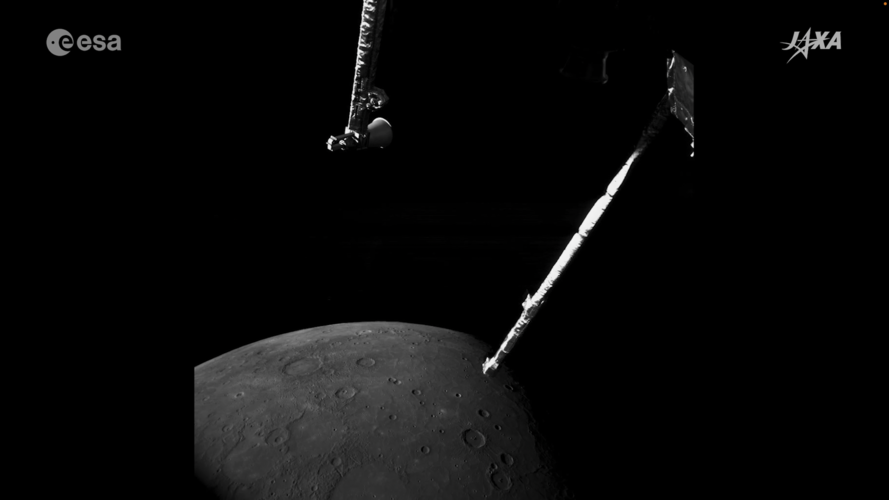Space News & Blog Articles
BepiColombo's sixth Mercury flyby: the movie
 Video:
00:01:36
Video:
00:01:36
Fly over Mercury with BepiColombo for the final time during the mission’s epic expedition around the Sun. The ESA/JAXA spacecraft captured these images of the Solar System's smallest planet on 7 and 8 January 2025, before and during its sixth encounter with Mercury. This was its final planetary flyby until it enters orbit around the planet in late 2026.
The video begins with BepiColombo's approach to Mercury, showing images taken by onboard monitoring cameras 1 and 2 (M-CAM 1 and M-CAM 2) between 16:59 CET on 7 January and 01:45 CET on 8 January. During this time, the spacecraft moved from 106 019 to 42 513 km from Mercury's surface. The view from M-CAM 1 is along a 15-metre-long solar array, whereas M-CAM 2 images show an antenna and boom in the foreground.
After emerging into view from behind the solar array, Mercury appears to jump to the right. Both the spacecraft and its solar arrays rotated in preparation for passing through Mercury's cold, dark shadow.
For several hours after these first images were taken, the part of Mercury’s surface illuminated by the Sun was no longer visible from the M-CAMs. BepiColombo's closest approach to Mercury took place in darkness at 06:58:52 CET on 8 January, when it got as close as 295 km.
Shortly after re-emerging into the intense sunlight, the spacecraft peered down onto the planet's north pole, imaging several craters whose floors are in permanent shadow. The long shadows in this region are particularly striking on the floor of Prokofiev crater (the largest crater to the right of centre) – the central peak of that crater casts spiky shadows that exaggerate the shape of this mountain.
Next, we have a beautiful view of Mercury crossing the field of view from left to right, seen first by M-CAM 1 then by M-CAM 2 between 07:06 and 07:49 CET. These images showcase the planet's northern plains, which were smoothed over billions of years ago when massive amounts of runny lava flowed across Mercury's cratered surface.
The background music is The Hebrides overture, composed by Felix Mendelssohn in 1830 after being inspired by a visit to Fingal’s Cave, a sea cave created by ancient lava flows on the island of Staffa, Scotland. Similarly shaped by lava is Mercury's Mendelssohn crater, one of the large craters visible passing from left to right above the solar array in M-CAM 1's views, and at the very bottom of M-CAM 2's views. The Mendelssohn crater was flooded with lava after an impact originally created it.
The end of the video lingers on the final three close-up images that the M-CAMs will ever obtain of Mercury. The cameras will continue to operate until September 2026, fulfilling their role of monitoring various parts of the spacecraft. After that point, the spacecraft module carrying the M-CAMs will separate from BepiColombo's other two parts, ESA's Mercury Planetary Orbiter (MPO) and JAXA's Mercury Magnetospheric Orbiter (Mio). MPO’s much more powerful science cameras will take over from the M-CAMs, mapping Mercury over a range of colours in visible and infrared light.
When you subscribe to the SpaceZE News Feed, we will send you an e-mail when there are new updates on the site so you wouldn't miss them.

